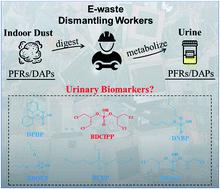当前位置:
X-MOL 学术
›
Environ. Sci.: Processes Impacts
›
论文详情
Our official English website, www.x-mol.net, welcomes your
feedback! (Note: you will need to create a separate account there.)
Organophosphate flame retardants and diesters in the urine of e-waste dismantling workers: associations with indoor dust and implications for urinary biomonitoring
Environmental Science: Processes & Impacts ( IF 4.3 ) Pub Date : 2020-12-29 , DOI: 10.1039/d0em00439a Rui-Xin Qin 1, 2, 3, 4, 5 , Bin Tang 1, 2, 3, 4, 5 , Xi Zhuang 1, 2, 3, 4, 5 , Wei-Xiang Lei 1, 2, 3, 4, 5 , Mei-Huan Wang 1, 2, 3, 4, 5 , Luo-Hong Zhang 5, 6, 7, 8 , Ke-Mei Hu 1, 2, 3, 4, 5
Environmental Science: Processes & Impacts ( IF 4.3 ) Pub Date : 2020-12-29 , DOI: 10.1039/d0em00439a Rui-Xin Qin 1, 2, 3, 4, 5 , Bin Tang 1, 2, 3, 4, 5 , Xi Zhuang 1, 2, 3, 4, 5 , Wei-Xiang Lei 1, 2, 3, 4, 5 , Mei-Huan Wang 1, 2, 3, 4, 5 , Luo-Hong Zhang 5, 6, 7, 8 , Ke-Mei Hu 1, 2, 3, 4, 5
Affiliation

|
Indoor dust ingestion is one of the main pathways for human exposure to organophosphate flame retardants (PFRs). The urinary concentrations of diesters (DAPs) are usually used as biomarkers to assess human exposure to PFRs. In this study, the PFR and DAP levels were measured in morning and evening urine samples of 30 workers from an e-waste dismantling site in southern China. The indoor dust samples were also collected from workshops and houses for analyzing associations between PFR and DAP levels in urine and dust. Tris(1-chloro-2-propyl) phosphate (TCIPP) and triphenyl phosphate (TPHP) were the dominant PFRs in dust, while bis(2-chloroethyl) phosphate (BCEP) and diphenyl phosphate (DPHP) were the major DAPs in dust. A significant positive correlation was observed between TPHP and DPHP concentrations in dust (p < 0.001), suggesting their potentially same source and the degradation of TPHP to form DPHP. TCIPP and tris(1,3-dichloro-2-propyl) phosphate (TDCIPP) were the predominant PFRs, and BCEP, bis(1,3-dichloro-2-propyl) phosphate (BDCIPP), and DPHP were the main DAPs in both the morning and evening urine samples. The DPHP levels in evening urine samples were significantly correlated with TPHP and DPHP levels (p < 0.01) in dust. A similar correlation was found for the BCEP levels in the evening urine samples and the TCEP and BCEP levels (p < 0.01) in dust. These results indicated that in addition to being biotransformed from their respective parent PFRs, direct ingestion from indoor dust could also be the potential source for urinary DPHP and BCEP. Since relatively low detection frequencies were observed for bis(1-chloro-2-propyl) phosphate (BCIPP) and bis(butoxyethyl) phosphate (BBOEP) in urine, they may not be the major metabolites of TCIPP and tris(2-butoxyethyl) phosphate (TBOEP), respectively, in the human body. However, BDCIPP can be considered a useful biomarker because it is a unique metabolite of TDCIPP and has high detection frequencies in urine samples. The results of this study indicated the limitations of solely using urinary DAPs as biomarkers for the evaluation of human exposure to PFRs, and certain PFRs as well as hydroxylated PFRs (OH-PFRs) should also be considered for urinary biomonitoring in future studies.
中文翻译:

电子废物拆解工人尿液中的有机磷阻燃剂和二酯:与室内灰尘的关系以及对尿液生物监测的意义
室内吸入粉尘是人类接触有机磷酸酯阻燃剂(PFR)的主要途径之一。二酯(DAP)的尿浓度通常用作评估人类暴露于PFR的生物标记。在这项研究中,PFR和DAP水平是在华南某电子废物拆解场的30名工人的早,晚尿液样本中测量的。还从车间和房屋中收集室内灰尘样品,以分析尿液和灰尘中PFR和DAP水平之间的关联。磷酸三(1-氯-2-丙基)酯(TCIPP)和磷酸三苯酯(TPHP)是粉尘中的主要PFR,而磷酸双(2-氯乙基)酯(BCEP)和磷酸二苯酯(DPHP)是粉尘中的主要DAP。 。灰尘中TPHP和DPHP浓度之间存在显着正相关(p<0.001),表明它们的潜在来源以及TPHP降解为DPHP的形式。TCIPP和磷酸三(1,3-二氯-2-丙基)酯(TDCIPP)是主要的PFR,而BCEP,磷酸双(1,3-二氯-2-丙基)酯(BDCIPP)和DPHP是主要的DAP。早晨和晚上的尿液样本。晚上尿液样本中的DPHP水平与粉尘中的TPHP和DPHP水平显着相关(p <0.01)。在夜间尿液样本中的BCEP水平与TCEP和BCEP水平之间也发现了相似的相关性(p<0.01)在灰尘中。这些结果表明,除了从各自的母体PFR中进行生物转化外,从室内灰尘直接摄入也可能是尿DPHP和BCEP的潜在来源。由于尿液中的磷酸双(1-氯-2-丙基)酯(BCIPP)和磷酸双(丁氧基乙基)酯(BBOEP)的检测频率相对较低,因此它们可能不是TCIPP和三(2-丁氧基乙基)的主要代谢产物。磷酸盐(TBOEP),分别在人体中。但是,BDCIPP是TDCIPP的独特代谢产物,在尿液样本中具有很高的检测频率,因此被认为是有用的生物标志物。这项研究的结果表明,仅使用尿液中的DAPs作为生物标志物来评估人体暴露于PFR的局限性,
更新日期:2021-01-29
中文翻译:

电子废物拆解工人尿液中的有机磷阻燃剂和二酯:与室内灰尘的关系以及对尿液生物监测的意义
室内吸入粉尘是人类接触有机磷酸酯阻燃剂(PFR)的主要途径之一。二酯(DAP)的尿浓度通常用作评估人类暴露于PFR的生物标记。在这项研究中,PFR和DAP水平是在华南某电子废物拆解场的30名工人的早,晚尿液样本中测量的。还从车间和房屋中收集室内灰尘样品,以分析尿液和灰尘中PFR和DAP水平之间的关联。磷酸三(1-氯-2-丙基)酯(TCIPP)和磷酸三苯酯(TPHP)是粉尘中的主要PFR,而磷酸双(2-氯乙基)酯(BCEP)和磷酸二苯酯(DPHP)是粉尘中的主要DAP。 。灰尘中TPHP和DPHP浓度之间存在显着正相关(p<0.001),表明它们的潜在来源以及TPHP降解为DPHP的形式。TCIPP和磷酸三(1,3-二氯-2-丙基)酯(TDCIPP)是主要的PFR,而BCEP,磷酸双(1,3-二氯-2-丙基)酯(BDCIPP)和DPHP是主要的DAP。早晨和晚上的尿液样本。晚上尿液样本中的DPHP水平与粉尘中的TPHP和DPHP水平显着相关(p <0.01)。在夜间尿液样本中的BCEP水平与TCEP和BCEP水平之间也发现了相似的相关性(p<0.01)在灰尘中。这些结果表明,除了从各自的母体PFR中进行生物转化外,从室内灰尘直接摄入也可能是尿DPHP和BCEP的潜在来源。由于尿液中的磷酸双(1-氯-2-丙基)酯(BCIPP)和磷酸双(丁氧基乙基)酯(BBOEP)的检测频率相对较低,因此它们可能不是TCIPP和三(2-丁氧基乙基)的主要代谢产物。磷酸盐(TBOEP),分别在人体中。但是,BDCIPP是TDCIPP的独特代谢产物,在尿液样本中具有很高的检测频率,因此被认为是有用的生物标志物。这项研究的结果表明,仅使用尿液中的DAPs作为生物标志物来评估人体暴露于PFR的局限性,











































 京公网安备 11010802027423号
京公网安备 11010802027423号